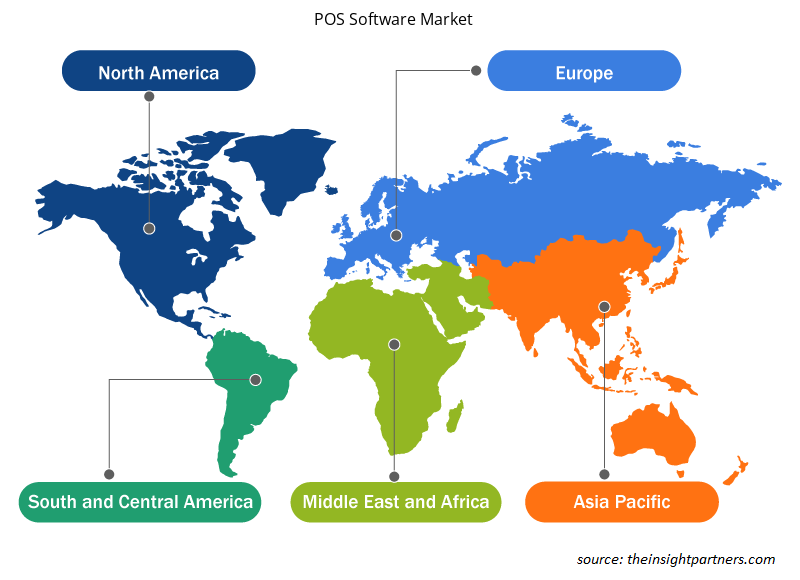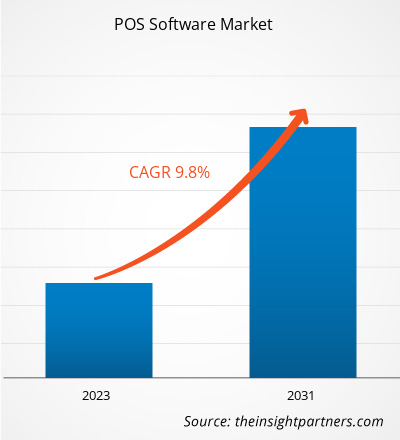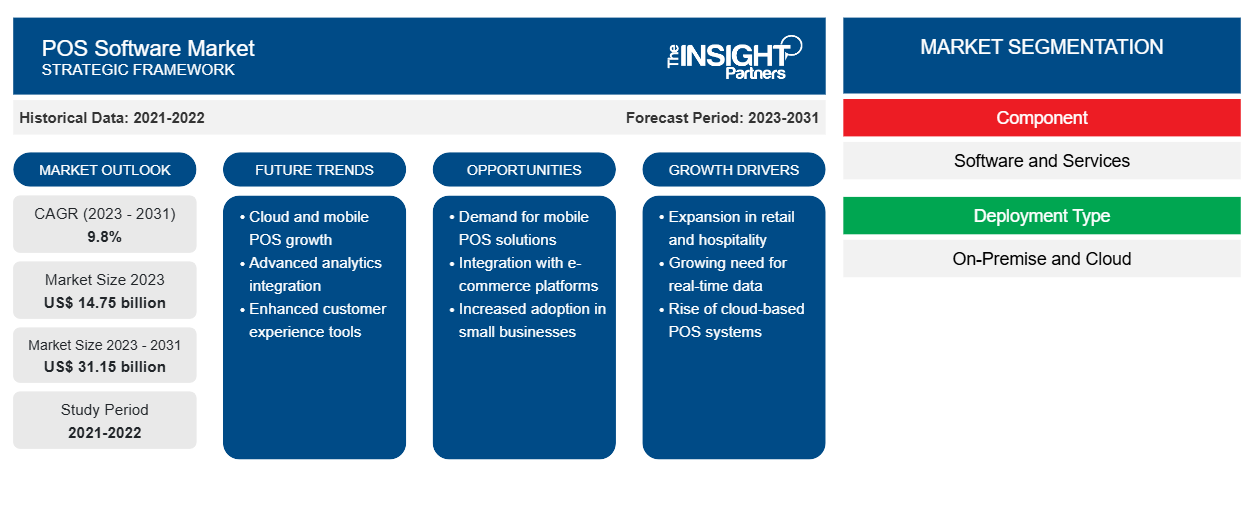POS 软件市场规模预计将从 2023 年的 147.5 亿美元增至 2031 年的 311.5 亿美元。预计 2023 年至 2031 年期间,该市场的复合年增长率为 9.8%。云计算服务的使用不断增加可能仍是 POS 软件市场的一个关键趋势。
POS 软件市场分析
进行无现金交易、跟踪销售和库存数据以及利用分析来优化零售连锁店、餐馆、酒店、药店、汽车修理店和其他地方的销售策略的必要性推动了对销售点 (POS) 软件的需求。由于对包括客户数据管理、库存跟踪、销售监控、员工管理分析和报告在内的高级功能的需求不断增长,预计 POS 软件的使用将在各个行业中增加。此外,对基于云的移动销售点软件的需求不断增长可能归因于对基于云的解决方案的日益接受。
POS 软件市场概览
销售点 (POS) 软件是一种专门的应用程序,企业使用它在销售点(通常在零售环境中)进行交易。通过跟踪销售、控制库存和处理付款,它可以加快结账流程。为了保证准确性,销售点软件经常与条形码扫描仪、收银机和读卡器等硬件交互。此外,它还具有处理客户信息、创建销售报告和评估的工具。
定制此报告以满足您的需求
您可以免费定制任何报告,包括本报告的部分内容、国家级分析、Excel 数据包,以及为初创企业和大学提供优惠和折扣
-
获取此报告的关键市场趋势。这个免费样品将包括数据分析,从市场趋势到估计和预测。
POS 软件市场驱动因素和机遇
电子商务行业蓬勃发展
随着在线和全渠道购物的日益普及,企业需要能够无缝连接线下和线上销售渠道的销售点 (POS) 软件。这推动了对包括库存控制、订单履行和客户关系管理(CRM) 等功能的销售点 (POS) 系统的需求,从而推动了 POS 软件市场的增长。
商业智能和数据分析需求不断增长
销售点 (POS) 软件正成为企业用来收集和检查有关销售、客户行为、库存和员工绩效的数据的越来越流行的工具。复杂的分析和报告技术可以帮助企业做出数据驱动的决策,提高客户满意度并减少程序。因此,预计 POS 软件的这些优势将在预测期内推动市场增长。
POS 软件市场报告细分分析
POS 软件市场分析的关键部分包括组件(软件和服务);部署类型(本地和云);应用程序和最终用户
- 根据组件,POS 软件市场分为软件和服务。软件部分在 2023 年占据了更大的市场份额。
- 根据部署类型,市场分为本地部署和云部署。2023 年,本地部署部分占据了更大的市场份额。
- 根据应用,市场细分为库存跟踪、采购管理、销售报告、客户参与等。库存跟踪部分在 2023 年占据了更大的市场份额。
- 根据最终用户,市场分为零售、酒店、媒体和娱乐、医疗保健等。零售业在 2023 年占据了最大的市场份额。
POS 软件市场份额按地区分析
POS 软件市场报告的地理范围主要分为五个区域:北美、亚太地区、欧洲、中东和非洲以及南美/南美洲和中美洲。
就收入而言,北美占据了最大的 POS 软件市场份额。该地区的市场分为美国、加拿大和墨西哥。该地区拥有许多知名的 POS 软件制造商,并且对复杂的集成 POS 软件的需求很高。此外,该地区的零售业正在经历巨大的增长,推动了市场的增长。此外,由于需要升级与保险、支付和患者管理相关的医院设施,预计美国医疗保健行业将以最快的速度增长。
POS 软件市场新闻和最新发展
POS 软件市场通过收集一级和二级研究后的定性和定量数据进行评估,其中包括重要的公司出版物、协会数据和数据库。以下是言语和语言障碍市场的发展和策略列表:
- 支付服务行业领导者美国银行宣布推出嵌入式多渠道销售点贷款解决方案 Avvance。Avvance 使企业能够在结账时提供消费者融资,并具有快速申请和即时决策的能力。(来源:Elavon Inc.,新闻稿,2023 年)
- NCR 公司推出了 NCR Aloha Cloud,这是一款基于云的销售点 (POS) 解决方案,其功能强大到足以以行业领先的 Aloha 品牌推向市场。Aloha Cloud 提供了更新的用户界面 (UI)、市场上最小的手持设备以及无缝支付处理和次日存款,让运营商有更多时间专注于经营餐厅。(新闻稿,2022 年)
POS 软件市场区域洞察
Insight Partners 的分析师已详细解释了预测期内影响 POS 软件市场的区域趋势和因素。本节还讨论了北美、欧洲、亚太地区、中东和非洲以及南美和中美洲的 POS 软件市场细分和地理位置。

- 获取 POS 软件市场的区域特定数据
POS 软件市场报告范围
| 报告属性 | 细节 |
|---|---|
| 2023 年的市场规模 | 147.5亿美元 |
| 2031 年市场规模 | 311.5亿美元 |
| 全球复合年增长率(2023 - 2031) | 9.8% |
| 史料 | 2021-2022 |
| 预测期 | 2023-2031 |
| 涵盖的领域 |
按组件
|
| 覆盖地区和国家 |
北美
|
| 市场领导者和主要公司简介 |
|
POS 软件市场参与者密度:了解其对业务动态的影响
POS 软件市场正在快速增长,其驱动力是终端用户需求的增加,而这些需求又源于消费者偏好的不断变化、技术进步以及对产品优势的认识不断提高等因素。随着需求的增加,企业正在扩大其产品范围,进行创新以满足消费者的需求,并利用新兴趋势,从而进一步推动市场增长。
市场参与者密度是指在特定市场或行业内运营的企业或公司的分布情况。它表明在给定市场空间中,相对于其规模或总市场价值,有多少竞争对手(市场参与者)存在。
在 POS 软件市场运营的主要公司有:
- Infor公司
- Intuit 公司
- 光速
- 甲骨文公司
- 三叶草网络有限责任公司
- NCR 公司
免责声明:上面列出的公司没有按照任何特定顺序排列。

- 获取 POS 软件市场顶级关键参与者概述
POS 软件市场报告覆盖范围和交付成果
“POS 软件市场规模和预测(2023-2031)”报告对市场进行了详细的分析,涵盖以下领域:
- 范围内涵盖的所有主要细分市场的全球、区域和国家层面的市场规模和预测
- 市场动态,如驱动因素、限制因素和关键机遇
- 未来主要趋势
- 详细的 PEST/波特五力分析和 SWOT 分析
- 全球和区域市场分析涵盖关键市场趋势、主要参与者、法规和最新市场发展
- 行业格局和竞争分析,涵盖市场集中度、热点图分析、知名参与者和最新发展
- 详细的公司简介
- 历史分析(2 年)、基准年、预测(7 年)及复合年增长率
- PEST和SWOT分析
- 市场规模、价值/数量 - 全球、区域、国家
- 行业和竞争格局
- Excel 数据集
近期报告
相关报告
客户评价
购买理由
- 明智的决策
- 了解市场动态
- 竞争分析
- 客户洞察
- 市场预测
- 风险规避
- 战略规划
- 投资论证
- 识别新兴市场
- 优化营销策略
- 提升运营效率
- 顺应监管趋势























 获取免费样品 - POS软件市场
获取免费样品 - POS软件市场